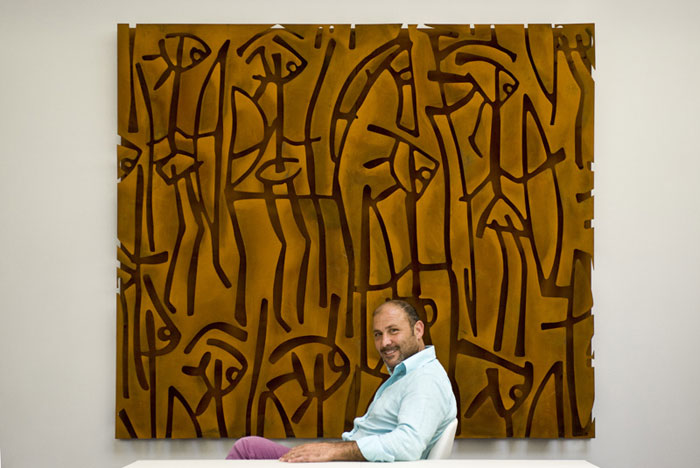Garden
The installation consists of a series of marine steel structures, wheels deformed to resemble prickly pear pallets, which are set against a supporting structure made of corten steel, representing the trunk of the fig tree itself. The trunk itself is made up of a series of masks with deformed features. The viewer is presented with a multiple impression: from time to time one observes the wheels in their impossible movement, constrained in their irregular frames, like donkey ears, or the rusty masks stand out, and finally, as a whole, one observes the entire vegetal structure of the plant. One of the characteristics of the prickly pear plant is that it can reproduce not only sexually but also by budding, it can multiply by simple spontaneous division, through the leaves, by cloning its own cells. And so, just as my work has always been a research into the spasmodic and obsessive multiplication of the identical, so I find in the way the prickly pear plant reproduces itself the similar paroxysmal and persecutory mechanism that distinguishes my work. The work seems to remind us how, on the one hand, the wheels of history have stopped, they no longer turn, since the space to contain them has run out, and how each one of us, like a hamster in the wheel, invents a more or less circular trajectory each time, in the destiny of our own practice of existing, and how each of us, like a hamster in the wheel, invents a more or less circular trajectory in the destiny of our own practice of existing, which holds back our inertia and, on the other hand, how the plant continues to grow despite everything, to reproduce itself by multiplying its leaves, this time by detachment, in the globalised horizon of all metastatic systems, where everything reproduces itself without order and brake. The burnished root of the trunk, coagulated in the grimace of so many ancestral ancestors, like so many links of a broken chain, resists in its effort to bear the weight of meaning and stands as a warning and a guardian of our already completed disappearance.
Sergio Fermariello
In the hands of the artist, symbols and ideograms thicken and multiply until they seem like a swarming anthill of concepts and references, they grow until they become a memento mori for an entire people, they are engraved and printed in the hardest metal until they become as imposing as banners, and they always imply the ability to capture, convince, transport, and make the most of the experience of the artist. But convince of what? Convey where? It is not clear, because the author has made ambiguity – between background and foreground, between canvas and relief, between shading and shadow, between the historical sense of the image and possible new interpretations – one of his strong points, but it is clear that what counts for him, more than the message, more than understanding, is the vehicle of meaning. As if writing were not a means but an end, as if icons and signs were not to be interpreted but could live a life of their own. Almost as if, on the canvases, in the sculptures and in the installations, one should not find a story summed up and handed down by a series of symbols but rather graphics and drawings that, each time, stage a different story, all yet to be seen and told.
Maurizio Sciaccaluga
Sergio Fermaniello was born in Naples in 1961. In 1989 he exhibited for the first time at the Lucio Amelio Gallery in Naples, with which he began a long collaboration. In the same year he won the Saatchi & Saatchi International Prize for Young Artists at the Palazzo delle Stelline in Milan. In 1990 he exhibited at the Galleria Il Capricorno in Venice and in 1992 at the Galerie Yvon Lambert in Paris. He participated in several international events such as the Metropolis exhibition at the International Kunstausstellung in Berlin and the Les pictographes exhibition at the Musèe de l’Abbaye Sainte-Croix in Les Sables-d’Olonne in 1991. In 1993 he participated in the 45th edition of the Venice Biennale with a solo room in the Italian Pavilion. In 1995 he exhibited Opus Alchemico at the Galleria In Arco in Turin, in 1996 ContemporaneaComo 2 at Villa Olmo in Como and Homo necans at the Galleria Lucio Amelio in Naples. In 1997 the exhibition Sergio Fermariello. Lavori 1990-1997 was held at the Istituto Italiano di Cultura in Cologne and in 1999 he created the installationAvviso ai Naviganti at Castel dell’Ovo in Naples. In the same year he exhibited at the Jan Wagner Gallery in Berlin, in 2000 at the Galleria Ronchini in Terni and at the Galleria Scognamiglio & Teano in Naples. In 2004 a retrospective exhibition was dedicated to him at Castel Sant’Elmo in Naples and in 2005 he created an installation in the “pier17” dock in New York. In the same year he had a solo exhibition at the Galleria Scognamiglio in Naples and at the Galleria Ronchino Arte Contemporanea in Terni, in 2006 at the Galleria Buonanno in Milan and at the Galleria Erica Fiorentini in Rome; in 2007 at the Galleria Fioretto in Padua and in 2008 at the Galleria Ronchino in Terni. In 2009 he had two personal exhibitions at MAC in Niteroi, Brazil and at PAN in Naples.







